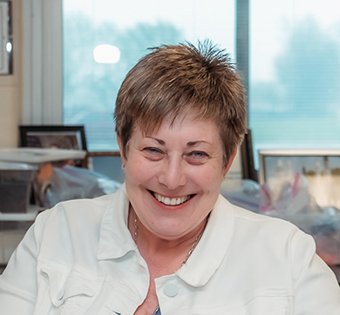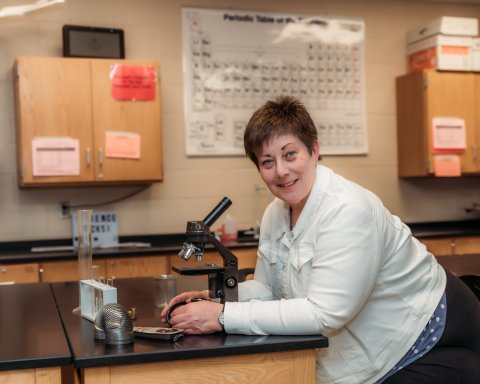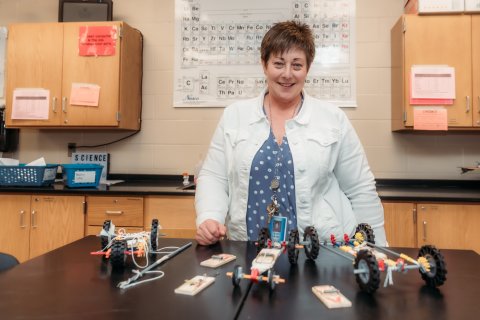
Engineering or teaching?
That was the career decision Annette (Ann) Drake faced a couple decades ago.
Ann, who earned her B.S. in civil engineering from Ohio Northern University in 1989, was working at an engineering consulting firm in Indiana when she began volunteering at her daughter’s school.
“It was awesome,” she said of the experience.
However, she knew if she wanted to change careers, she would have to get a master’s degree in education. Alternatively, if she wanted to move up to a partnership at her engineering firm, she would also have to get her master’s degree.
She chose teaching.
“I thought, well, you know, I’m just going to take the leap,” Ann recalled.
Ann earned a master’s degree in education from Wright State University. Today, more than 25 years later, she is an award-winning teacher at Brookville Intermediate School in Brookville, Ohio.
This past January, she received the nation’s highest recognition for STEM educators: the Presidential Award for Excellence in Mathematics and Science Teaching, presented by President Joe Biden.
Ann, who teaches 7th grade science, still brings her ONU engineering roots into the classroom every day.
“Being an engineer, you learn a lot of science and math, and as a teacher, you teach a lot of science and math,” she said. “But it’s not just about the content, it’s about how you think about and how you approach problems.”
As an engineer, she added, she was challenged to use high level math and science to solve problems that were new and unique, and, as a teacher, she faces similar challenges. “Each kid is different and each problem we encounter or challenge we face is unique to that kid.”
Over the years, she’s taught several different subjects and grade levels, but she finds 7th graders to be special. “They’re funny, they’re silly, they’re goofy. They’re just trying to figure it all out. It’s my favorite grade.”
Ann’s classes cover a broad range of science topics, but her favorite subjects to teach are physical and environmental science. She loves physical science for “all the fun equipment you get to play with,” she said, and environmental science because she can take students outside in the natural world to observe.
Her teaching style is innovative, hands-on, and project-based. For example, in 2017, she led her students in creating a website dedicated to exploring and promoting biodiversity in Brookville. The students researched the topic through books, online resources, and visits with a park district expert. In that first year, the students designed QR codes that could be added to park signage to share with the public what they learned.
Each year, students continue to expand the site, creating new products and adding to the different subjects with podcasts, infographics, and posters.
“The students really take ownership because it’s out in the public and the public can see it,” she said.
In a special class on engineering principles, she fosters curiosity by challenging students to build, tinker, and problem-solve.
She encourages what she calls “failing forward “— trying and failing, then trying again to see what works and what doesn’t work, then taking what works and moving on with that.
“It’s a fun class. The kids think they’re playing, but they’re really learning.”
Ann wants her students to enjoy science and not fear that it’s too difficult.
“I frame it so it’s not challenging and impossible by linking to what they already know,” she said. “They already know science and they’re already good at it, so I tell them we’re going to take what you already know and build on it.”
Her decision to build on her engineering background and step into the classroom has many rewards, she said. The biggest one? “When kids have that ‘aha’ moment or go ‘wow,’ I really know this,’ and I’m thinking, ‘yes, you really do!’”

